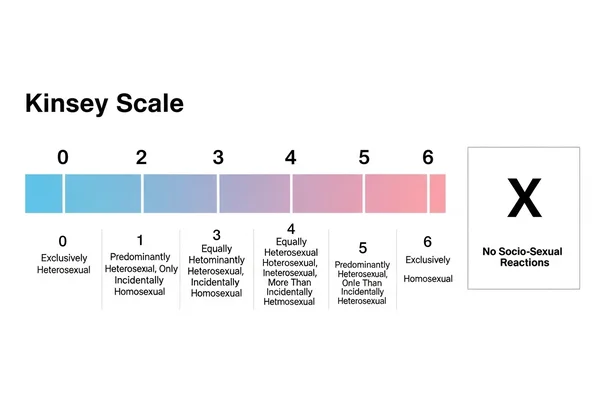Kinsey Scale Score Meaning: A Guide to Understanding Your Test Results
You have your Kinsey Scale score. It’s a number, sitting there on the screen, and it might bring up a mix of feelings: curiosity, confusion, validation, or maybe even a little uncertainty. This is a completely normal and important moment in your journey of self-discovery. If you're looking at that number and asking, "What does my Kinsey score mean for me?", you've come to the right place. This guide is here to help you navigate those feelings and understand that this score isn't a rigid label, but a starting point for a meaningful exploration of your unique identity. The kinsey scale is a tool, and this is your manual for using it for personal growth.
Your exploration is a personal and private journey. When you feel ready to reflect further, you can always start your exploration with our user-friendly and confidential test.
How to Understand Your Kinsey Results Personally
Receiving a score on any sexuality test can feel significant, but its true value lies in personal interpretation. It's a reflection of your experiences and feelings at a specific point in time. The goal is not to fit you into a box, but to provide a new lens through which you can view yourself with greater clarity and compassion. Understanding your result is the first step toward embracing the full spectrum of your identity.
A Score is a Snapshot, Not a Final Definition
The most crucial thing to remember is that your score is not set in stone. Think of it as a snapshot of your feelings and experiences right now, not a lifelong definition carved into your identity. Dr. Alfred Kinsey’s groundbreaking research highlighted the concept of sexual fluidity—the idea that a person's attractions and behaviors can change and evolve over time. Your life is dynamic, and so is your identity.

A score you receive today might differ from one you would have received five years ago or one you might get five years from now. This doesn't make your current result invalid; it simply honors the reality that human experience is not static. Embrace this number as a piece of information for your present self, a tool to help you understand where you are on your personal journey right now.
What the Numbers on the Kinsey Scale Mean
The Heterosexual-Homosexual Rating Scale, popularly known as the Kinsey Scale, operates on a 0-to-6 spectrum. It was designed to show that sexuality is not a simple binary. Let’s break down the general meaning of the numbers on the Kinsey Scale:

- 0 - Exclusively Heterosexual: Individuals who identify as a 0 experience attraction and have sexual experiences only with the opposite sex.
- 1 - Predominantly Heterosexual, Only Incidentally Homosexual: These individuals are primarily heterosexual but have had incidental or occasional attractions or experiences with the same sex.
- 2 - Predominantly Heterosexual, but More Than Incidentally Homosexual: Attraction is still mainly heterosexual, but same-sex attraction is more than a fleeting thought or rare occurrence.
- 3 - Equally Heterosexual and Homosexual: This score represents the midpoint, often associated with bisexuality, where attraction to both sexes is roughly equal.
- 4 - Predominantly Homosexual, but More Than Incidentally Heterosexual: Attraction is primarily geared toward the same sex, with more than occasional attractions to the opposite sex.
- 5 - Predominantly Homosexual, Only Incidentally Heterosexual: These individuals are almost entirely homosexual but have had incidental attractions or experiences with the opposite sex.
- 6 - Exclusively Homosexual: Individuals who identify as a 6 experience attraction and have sexual experiences only with the same sex.
- X - No Socio-Sexual Contacts or Reactions: The 'X' category is for individuals who do not experience sexual attraction or have overt sexual experiences. This is often associated with asexuality today.
If you're curious about how your personal experiences translate into a score, you can always take our free test in a safe and private environment.
It's About More Than Just Behavior
A common misunderstanding of the Kinsey Scale is that it only measures physical actions. However, the scale is much more nuanced. When you take a Kinsey Scale Test, it considers three key facets of your sexuality: your sexual behaviors, your sexual fantasies, and your romantic or emotional attraction.
You might have only had relationships with one gender but find yourself fantasizing about or feeling emotionally drawn to another. The Kinsey Scale acknowledges this complexity. It affirms that your inner world of attraction and fantasy is just as valid a part of your sexual identity as your external actions. This comprehensive view makes the scale a more holistic tool for self-understanding.
What to Do After Taking a Sexuality Test
So, you have your score and a better understanding of what it represents. Now what? The next steps are entirely up to you. This is your opportunity to turn information into insight. The period after taking a sexuality test is a time for gentle reflection, not for making drastic decisions or feeling pressured to adopt a new label unless it feels right to you.
Journal Prompts for Self-Reflection
One of the most powerful things you can do is to sit with your results privately. Journaling can be an incredible tool for processing your thoughts and feelings without judgment. Here are a few journal prompts to get you started:

- When I first saw my score, what was my immediate feeling? (e.g., Surprise, relief, confusion, confirmation?)
- How does this score align with how I've seen myself over the years?
- Can I recall specific moments, feelings, or attractions in my life that this score helps me understand better?
- Does this new information change anything about how I want to live my life moving forward?
- What parts of my identity feel clear right now, and what parts still feel uncertain?
This is a private conversation with yourself. Be honest, be kind, and allow whatever comes up to simply be. This process of self-reflection is where the real value of the confidential kinsey scale quiz lies.
Considering Your Kinsey Scale Identity
Your kinsey scale identity is not something the test gives you; it's something you choose to build for yourself. The score is just a piece of data. You are the one who decides how, or if, you want to integrate it into your sense of self. For some, finding a score that resonates can be incredibly affirming, giving them a word or a framework (like bisexual, pansexual, or queer) that finally feels like home.
For others, the score might not fit neatly with any existing label, and that is perfectly fine. Your identity is uniquely yours, and you don't have to adopt any label that doesn't feel authentic. You might simply use the result as a quiet acknowledgment of your capacity for attraction across a spectrum, without needing to name it publicly. The choice is always yours.
When and How to Talk About Your Results
Deciding if, when, and with whom to talk about your results is a deeply personal decision. There is no right or wrong timeline. If you choose to share, consider starting with a trusted friend, partner, or family member who you know will be supportive and open-minded.

You could start the conversation by saying something like, "I've been doing some self-exploration recently, and I learned something about myself that I'd like to share with you." Explain what the scale is and what your result means to you personally. Remember, you don't owe anyone an explanation, but sharing can sometimes foster deeper connection and understanding. Your safety and comfort are paramount.
Understanding your Kinsey Scale results is not about finding a final answer. It's about opening a new chapter in your ongoing story of self-discovery. That number is a guidepost, not a destination. It offers you a moment to pause, reflect, and honor the beautiful complexity of your attractions and identity. Whether your score confirms what you always knew or opens your eyes to new possibilities, the journey is what matters.
Your path is your own, and every step of exploration is valuable. Ready to continue your journey or get deeper insights with an optional AI-powered analysis? Discover your results and see what you can learn.
Frequently Asked Questions About the Kinsey Scale
What is the Kinsey Scale?
The Kinsey Scale, officially the Heterosexual-Homosexual Rating Scale, is a model of sexual orientation created by Dr. Alfred Kinsey in the 1940s. Instead of seeing sexuality as a strict heterosexual/homosexual binary, it places individuals on a seven-point spectrum from 0 (exclusively heterosexual) to 6 (exclusively homosexual), including a category 'X' for those with no socio-sexual experiences. Our our interactive tool is designed to help you find your place on this spectrum through a series of reflective questions.
What does a score of 'X' on the Kinsey Scale mean?
A score of 'X' on the original Kinsey Scale was used for individuals who reported no socio-sexual contacts or reactions. In modern terms, this is often interpreted as aligning with asexuality or aromanticism, where a person may experience little to no sexual or romantic attraction. It's important to remember that 'X' is not a deficiency but a valid orientation on the vast spectrum of human sexuality.
Is the Kinsey Scale still relevant today?
This is a great question. While the Kinsey Scale was revolutionary for its time, modern understandings of sexuality have expanded to include identities like pansexuality, omnisexuality, and demisexuality, which the scale doesn't explicitly address. Critics also note its focus on a single gender binary. However, it remains a highly relevant and valuable tool for introducing the concept of a sexual spectrum and helping individuals begin their journey of self-exploration. It serves as an excellent starting point for understanding that attraction is not always black and white.